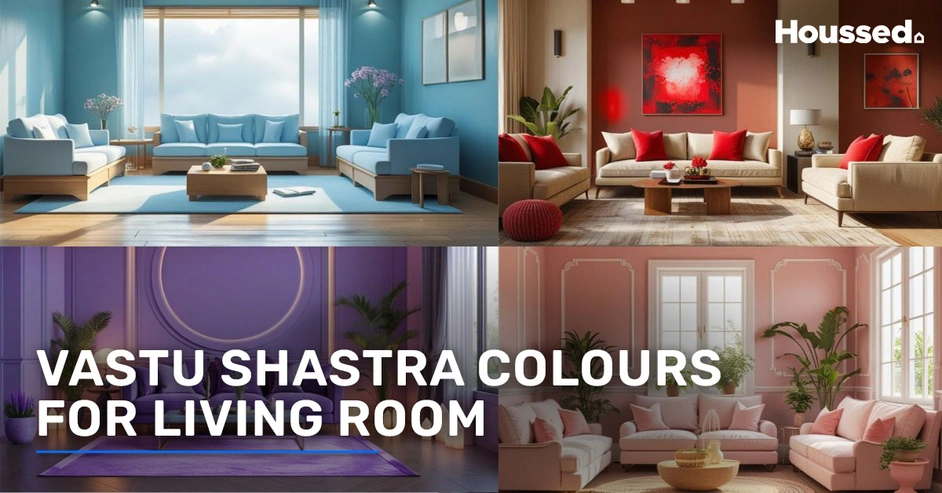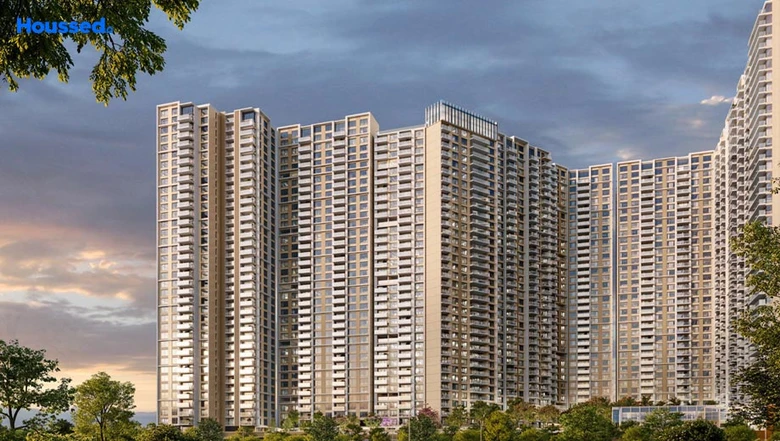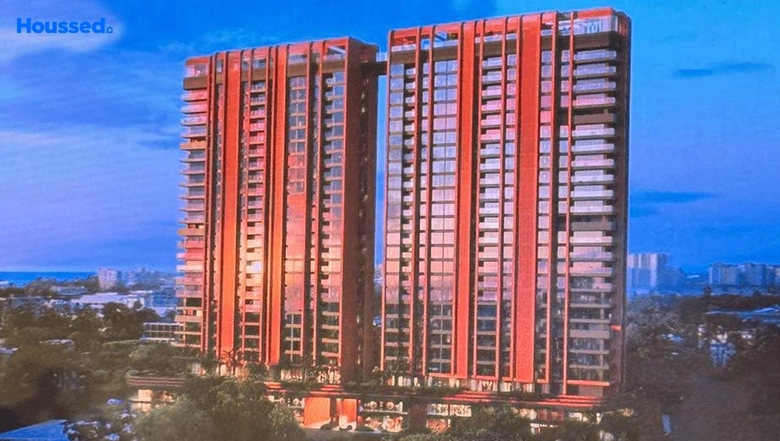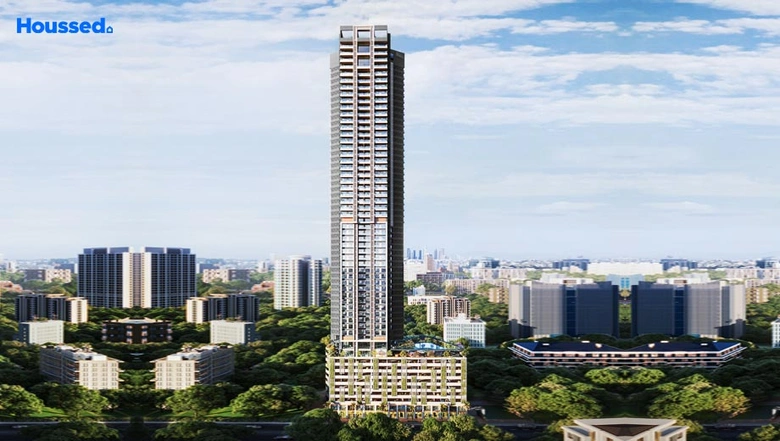Vastu Shastra Colours for Living Room: Tips, Benefits & More

According to Vastu Shastra, using the right colours in your living room can enhance harmony, reduce stress, and invite prosperity. On the other hand, using the wrong shades can unknowingly block positive energy or cause emotional imbalances.
In this guide, we’ll break down the best Vastu Shastra colours for the living room, explain how they affect energy, and give you practical tips and combinations that work.
You'll also discover what colours to avoid and how small changes can make a big difference in your home’s vibe.
Why Colours Matter in Vastu Shastra
In Vastu Shastra, every colour carries a unique frequency that influences the energy within a space. Just like sound or light, colours emit vibrations that can either uplift or disturb the atmosphere of your home.
Choosing Vastu-approved colours helps maintain a smooth, positive flow of energy, especially in high-traffic spaces like the living room.
Impact on Emotions, Mood, and Relationships
Colours affect more than just aesthetics—they directly influence how we feel and interact with others. For example:
- Blue promotes calm and trust
- Yellow brings warmth and cheerfulness.
- Green fosters balance and renewal
Connection with the Five Vastu Elements
Vastu is based on balancing five natural elements—earth, water, fire, air, and space—and each element is represented by specific colours:
- Earth (brown, beige): Stability and grounding
- Water (blue, sea green): Calm and flow
- Fire (red, orange): Energy and passion
- Air (white, light grey): Clarity and movement
- Space (purple, violet): Spiritual growth and openness
Also Read - Vastu Zones and Colours
Best Living Room Colours as per Vastu for Positive Energy
The following are the most recommended Vastu colours for the living room, along with their ideal usage and benefits.
Brown Shades
Earthy tones provide stability and grounding, essential for emotional balance.
-
Ideal for: South-west direction.
- Vastu Tip: Use light coffee, taupe, or beige browns for a cosy, rooted ambience.
Purple
Purple connects to the space element, inviting wisdom, luxury, and intuition.
-
Ideal for: Meditation corners or feature walls.
- Vastu Tip: Use lavender or lilac for a softer, more tranquil effect.
Pink
A gentle tone that fosters love, compassion, and emotional warmth.
-
Ideal for: Family-oriented living spaces.
- Vastu Tip: Blend with white for a nurturing and non-overpowering palette.
Red (As an Accent)
Red symbolises the fire element—passion and strength—but is overpowering in large areas.
-
Ideal for: Cushions, artwork, or a feature wall.
- Vastu Tip: Use sparingly to energise without disrupting the balance.
Soft Blue
A muted blue creates a spa-like calmness and enhances communication.
-
Ideal for: North or east walls.
- Vastu Tip: Pairs well with whites and wooden textures for a modern Vastu look.
Sea Green
Represents water and nature—bringing freshness and emotional cleansing.
-
Ideal for: North-east facing rooms.
- Vastu Tip: Especially effective when paired with white or pastel pink.
Light Grey
Symbolic of air, it encourages mental clarity, neutrality, and flexibility.
-
Ideal for: North-west or west directions.
- Vastu Tip: Blend with warm tones to avoid a cold or sterile feel.
Off-white
Enhances light and creates a spacious, clean, and calming environment.
-
Ideal for: Any direction; works well in compact or low-light rooms.
- Vastu Tip: Ideal base colour—acts like a blank canvas for positive energy.
Also Read - Southwest Bedroom Colour as per Vastu
Living Room Colour Combinations as Per Vastu
Choosing the right colour combinations in your living room, as per Vastu Shastra, not only enhances visual appeal but also harmonises energy flow for peace and positivity. Here are some effective Vastu-approved colour combos and their ideal uses:
Blue and White
Blue promotes calmness and peace, while white adds purity and openness.
-
Ideal for: West or north-west facing living rooms.
-
Vastu Tip: Incorporate natural textures to enhance relaxation and promote social bonding.
Yellow Combinations
Yellow represents optimism, cheer, and mental clarity.
-
Ideal for: North-east or east-facing living rooms.
- Vastu Tip: Use mustard or pastel yellow with white or grey for a balanced, airy vibe.
Orange, White & Brown
Orange brings warmth and vitality; brown grounds the energy; white keeps it balanced.
-
Ideal for: South or south-east directions.
- Vastu Tip: Best for energising social areas without overstimulation.
Green and Blue
Green symbolises growth and healing; blue offers serenity.
-
Ideal for: North or east-facing living rooms.
- Vastu Tip: Perfect for homes with indoor plants or nature-inspired décor.
Colours To Avoid in the Living Room as per Vastu
While some colours attract harmony and positivity, others can disturb the energy flow and emotional balance of your home.
According to Vastu Shastra, it is recommended to avoid the following shades in your living room, especially in large quantities or on dominant walls.
Dark Red
Represents the fire element in excess. Can create tension, aggression, and restlessness—especially in family spaces.
Vastu Tip: If you like red, use it only as a small accent.
Black
Absorbs energy and light, leading to heaviness and stagnation. Symbolises negativity and secrecy when overused.
Vastu Tip: Avoid black on large walls or furniture. Use only in small, balanced décor elements.
Dark Grey
Dark grey promotes dullness, confusion, and emotional heaviness. It can block the natural flow of energy in the living room.
Vastu Tip: If using grey, stick to lighter shades like dove or ash grey.
Deep Blue
While light blue is calming, dark or navy blue can make the space feel cold, isolating, and overly introspective.
Vastu Tip: Ideal only for minimal detailing or artistic accents—not full walls.
Dark Purple
Though purple represents spirituality, deep shades can overwhelm small or dimly lit spaces. May cause emotional imbalance or disconnection.
Vastu Tip: Use softer tints like lavender if you love purple tones.
Also Read - Southeast Entrance Vastu
Direction-Based Living Room Colours As Per Vastu
In Vastu Shastra, the direction your living room faces plays a vital role in deciding the ideal colours to enhance positive energy and harmony.
The following is a quick guide to choosing living room colours based on directions:
North-Facing Living Room
- Light Blue, White, Cream
- These colours represent the water element, promoting calmness, peace, and financial prosperity. Light shades also help reflect natural light, keeping the space bright and airy.
East-Facing Living Room
- Green, Light Yellow, Off-white
- East is linked to the air element and sunrise, symbolising growth and new beginnings. Green and light yellow stimulate freshness and positivity, encouraging health and vitality.
South-Facing Living Room
- Red, Orange, Terracotta, Brown
- The south direction corresponds to the fire element. Warm, earthy tones like terracotta and brown, along with energising shades like red or orange, bring enthusiasm, stability, and strength to the room.
West-Facing Living Room
- White, Blue, Grey
- West relates to the water element but also carries the energy of the setting sun. Cooler tones like blue and grey balance relaxation and introspection, while white maintains purity and openness.
North-East Living Room
- White, Light Blue, Light Green
- Considered highly auspicious, the northeast benefits from light, calming shades that enhance spiritual growth and mental clarity
South-West Living Room
- Earthy tones like Brown, Beige, and Cream
- This direction represents the earth element, so grounding colours support stability, safety, and nurturing energy.
Also Read - Southeast Corner Vastu
Benefits of Following Vastu Colours in the Hall
Choosing Vastu-compliant colours for your living room brings a range of benefits that enhance not only the aesthetics but also the overall energy and well-being of your home. Here’s how positive energy from the right colours can transform your living space:
- Harmony and Peace – Positive energy in the living room creates a harmonious and peaceful atmosphere, making it an ideal environment for relaxation and meaningful family bonding.
- Enhanced Social Interactions – Vastu-approved colours promote open communication and strengthen social connections among family members and guests, fostering a warm sense of unity.
- Stress Reduction – A living room charged with positive energy helps alleviate stress and anxiety, offering a calming sanctuary where occupants can unwind and recharge.
- Improved Concentration – Balanced energy flow enhances focus and mental clarity, turning your living room into a perfect spot for reading, working, or engaging in thoughtful conversations.
- Health and Well-being – Following Vastu colour principles supports overall health and vitality by promoting an environment rich in positive energy and balanced vibrations.
- Attracts Prosperity – Positive energy aligned with Vastu is believed to attract prosperity and abundance, creating a nurturing space that supports financial growth and stability.
- Positive Family Dynamics – A living room infused with Vastu colours reduces conflicts and encourages nurturing interactions, fostering healthy and supportive family relationships.
- Guest Comfort – Guests feel more welcomed and comfortable in a living room filled with positive, balanced energy, enhancing the overall hosting experience.
- Creativity and Inspiration – The right Vastu colours stimulate creativity and inspire innovative thinking, making your living room a conducive space for artistic and brainstorming activities.
- Balanced Energy Flow – Vastu ensures a smooth and balanced flow of energy throughout the living room, preventing stagnation and maintaining a vibrant, uplifting ambience.
Vastu Colour Tips for a Positive Living Room
1. Follow Direction-Based Colours
Match the wall colours with the room’s orientation:
- East: White, light blue, or light green
- North: Green or blue shades
- South: Red, coral, or orange accents
- West: Grey, white, or earthy tones
2. Prioritise Light and Natural Shades
Lighter hues (like cream, soft green, pastel blue) attract positivity and amplify natural light. These are ideal for creating a peaceful, vibrant space.
3. Use Accent Colours Wisely
Incorporate energising colours like red or orange as small décor elements—such as cushions, vases, or art—to avoid overstimulation.
4. Combine Colours Thoughtfully
Mix soothing base tones with bright accents:
- White + Blue = Calm and Clear
- Yellow + Beige = Warm and Welcoming
- Green + Brown = Balanced and Grounded
5. Avoid Overuse of Dark Colours
Limit the use of black, dark grey, or deep red—these can absorb energy and create a heavy atmosphere.
6. Refresh Colours Periodically
Faded or chipped walls can disrupt the energy flow. Repaint every few years to maintain a vibrant aura.
7. Sync Colours with Décor
Choose curtains, furniture, and accessories that complement your wall colours to reinforce the positive vibrations in the room.
8. Maximise Natural Light
Use Vastu-approved colours that reflect natural light—this keeps the living room bright and full of life.
9. Reflect Your Family’s Personality
Your colour choices should resonate emotionally with your family while still staying within Vastu principles.
10. Add Vastu Elements
Support your colour palette with:
- Plants (Earth + Air)
- Water bowls or fountains (Water)
- Candles or lamps (Fire)
Also Read - Vastu Tips for Home
Do’s and Don’ts for Living Room Colours as per Vastu
Do’s
- Do choose light and soothing colours like soft blues, off-whites, and pastel greens to invite calm and positive energy.
- Do use colours that align with the room’s direction (e.g., yellow for east, blue for north) to balance natural energies.
- Do add warm accents such as orange or red in small amounts to energise the space without overwhelming it.
- Do keep the colour palette balanced—mix warm and cool tones to maintain harmony.
- Do consider your family’s preferences and lifestyle along with Vastu principles for a personalised, comfortable living room.
- Do maintain cleanliness and brightness to allow colours to express their positive vibrations fully.
- Do use natural light to enhance the effect of Vastu-approved colours in the living room.
Don’ts
- Don’t use dark or dull colours excessively, like dark red, black, or dark grey, as they can create negative or stagnant energy.
- Don’t paint all walls in intense or vibrant shades such as bright red or deep purple, which can cause restlessness or conflict.
- Don’t ignore the direction and layout of the living room when selecting colours—it can disrupt energy flow.
- Don’t clutter the room with too many contrasting colours, which may confuse the energy and disrupt harmony.
- Don’t neglect maintenance—faded or chipped paint can block positive energy.
- Don’t overlook natural elements—incorporate earth tones and plants along with colours to balance the Vastu elements.
Summary
Why Colours Matter in Vastu Shastra
Choosing Vastu-approved colours helps maintain a smooth, positive flow of energy, especially in high-traffic spaces like the living room.
Best Living Room Colours as per Vastu for Positive Energy
- Brown Shades
- Purple
- Pink
- Red (As an Accent)
- Soft Blue
- Sea Green
- Light Grey
- Off-white
Living Room Colour Combinations as Per Vastu
- Blue and White
- Yellow Combinations
- Orange, White & Brown
- Green and Blue
Colours To Avoid in the Living Room as per Vastu
- Dark Red
- Black
- Dark Grey
- Deep Blue
- Dark Purple
Direction-Based Living Room Colours As Per Vastu
- North-Facing Living Room - Light Blue, White, Cream
- East-Facing Living Room - Green, Light Yellow, Off-white
- South-Facing Living Room - Red, Orange, Terracotta, Brown
- West-Facing Living Room - White, Blue, Grey
- North-East Living Room - White, Light Blue, Light Green
- South-West Living Room - Earthy tones like Brown, Beige, and Cream
Benefits of Following Vastu Colours in the Hall
- Harmony and Peace
- Enhanced Social
- Interactions Stress Reduction
- Improved Concentration
- Health and Well-being
- Attracts Prosperity
- Positive Family Dynamics
- Guest Comfort
- Creativity and Inspiration
- Balanced Energy Flow
Vastu Colour Tips for a Positive Living Room
1. Follow Direction-Based Colours
2. Prioritise Light and Natural Shades
3. Use Accent Colours Wisely
4. Combine Colours Thoughtfully
5. Avoid Overuse of Dark Colours
6. Refresh Colours Periodically
7. Sync Colours with Décor
8. Maximise Natural Light
9. Reflect Your Family’s Personality
10. Add Vastu Elements
Do’s and Don’ts for Living Room Colours as per Vastu
Do’s
- Do choose light and soothing colours
- Do use colours that align with the room’s direction
- Do add warm accents
- Do keep the colour palette balanced
- Do consider your family’s preferences and lifestyle
- Do maintain cleanliness and brightness
- Do use natural light
Don’ts
- Don’t use dark or dull colours excessively
- Don’t paint all walls in intense or vibrant shades
- Don’t ignore the direction and layout
- Don’t clutter the room with too many contrasting colours
- Don’t neglect maintenance
- Don’t overlook natural elements
FAQ's
Arrange the living room furniture to allow free flow of energy, avoiding clutter. Place a few green plants in the southeast corner for positivity. Paint the living room walls with earthly tones to have a peaceful atmosphere in the house.
Opt for soothing colours like light green, blue, or beige in the living room. Avoid any dark shades and choose colours that promote a calming atmosphere.
Colours play a crucial role in Vastu for the living room. Harmonious colours enhance positivity and well-being, fostering a balanced energy flow within the space.
Ensure the living room is well-lit with natural light. Use mirrors to amplify positive energy and place them on the north or east walls for optimal results.
To enhance positive energy in your home, incorporate elements like wind chimes and fresh flowers. Keep the space well-ventilated for good energy circulation.
Vastu-approved colours for positive energy include light shades of green, blue, yellow, and beige. Choose colours that resonate with your personal preferences while aligning with Vastu principles.
Stick to Vastu-approved colours like light blue, light green, or white for the living room. These colours promote a positive and vibrant atmosphere while avoiding darker tones.
Negative Vastu colours for the living room include deep red and black. These colours may disrupt positive energy flow and create a heavy atmosphere.
The red colour in the living room, as per Vastu, is associated with energy and passion. While it can bring vibrancy, use it in moderation to avoid overwhelming the space.
The blue colour in the living room is considered calming and conducive to the positive energy in Vastu. Use light blue or aqua shades to create a serene and peaceful atmosphere.
According to Vastu, positive energy in the living room promotes harmony, happiness, and overall well-being. It fosters a welcoming environment for family and guests.
Colours influence emotions and energy levels. Positive energy colours like light greens and blues in the home can induce calmness, reduce stress, and contribute to a harmonious living environment.









